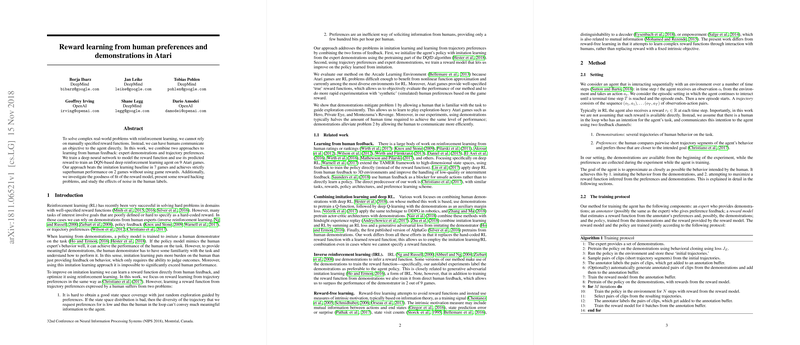Insights on "Reward Learning from Human Preferences and Demonstrations in Atari"
The paper, "Reward Learning from Human Preferences and Demonstrations in Atari," presents a novel reinforcement learning (RL) approach that integrates human feedback mechanisms to train agents in complex environments devoid of explicit reward functions. The authors advocate for leveraging expert demonstrations and trajectory preferences to devise reward functions that guide RL agents in Atari games. They assert that this method substantially advances imitation learning, especially in exploration-heavy tasks where traditional RL might falter due to poorly specified reward signals.
The authors engineer a mechanism that synthesizes human-derived feedback through two key conduits: expert demonstrations and trajectory preferences. This innovative approach is evaluated within the Arcade Learning Environment across nine Atari games, a domain renowned for its diverse and challenging RL problem-solving requirements bolstered by nonlinear function approximation necessities.
Methodology
Central to the authors' approach is the utilization of a deep neural network to approximate the reward function based on human feedback. This reward model is instrumental in training a Deep Q-Network (DQN)-based reinforcement learning agent. The procedure commences with pretraining the policy model based on demonstrations, followed by integration of trajectory preferences. An intriguing facet is the initialization with the DQfD algorithm, where policy is pretrained from demonstrations, augmented by captured trajectory preferences which serve as feedback loops reinforcing the reward model. This dual-source feedback ostensibly alleviates the inefficiencies inherent in relying solely on human-rated preferences or demonstrations.
Evaluation metrics eschew reliance on Atari's intrinsic reward systems, instead employing synthetic human preferences to emulate realistic human judgments. Comparative analyses against baseline imitation learning reveal the approach's efficacy in seven out of nine games, with distinct superhuman performance in two games sans intrinsic rewards.
Key Findings and Analysis
A major contribution is the demonstration of this approach overcoming traditional reinforcement learning's exploration challenges, particularly in games like Montezuma's Revenge and Private Eye. Additionally, the inclusion of expert demonstrations effectively halves the requisite human labeling time to achieve comparable performance levels. The paper articulates how pretraining on demonstrations and enriching synthetic preference labels from these demonstrations can substantially improve agent performance. This is a testament to the integrated approach's robustness, mitigating state space exploration issues.
It is noteworthy that the authors explore and document potential challenges like reward model misalignment and reward hacking—a scenario where the agent maximizes learned reward at the detriment of intended performance. By maintaining an ongoing learning interaction between the agent and human, such pitfalls are adeptly counteracted.
Despite these successes, the exploration illustrates the constraints of human preferences when synthesized versus real, indicating performance degradation in some games (e.g., Private Eye). Additional findings suggest that games with fine-grained scoring, such as Enduro, present alignment challenges seen in higher loss values, despite achieving optimal performance.
Implications and Future Developments
The implications of this research are substantial for fields that necessitate nuanced feedback-driven RL, such as robotic learning and interactive AI systems. The integration approach can cultivate agents capable of superseding baseline human-like performances without predefined reward functions. This aligns perfectly with tasks where human objectives might be too complex to encode explicitly.
Looking forward, the research prompts further inquiry into enhancing synthetic preference mechanisms and minimizing human feedback errors. Future studies may explore adaptable frameworks where human-feedback loops dynamically calibrate reward functions without heavy reliance on demonstrations. Additionally, it is prudent to explore policy-gradient methods juxtaposed with the demonstrated value-based DQN approach to ascertain algorithmic effectiveness for varying task attributes.
In summary, this paper represents a pivotal step in the refinement of AI models toward autonomous problem-solving capabilities by intelligently harnessing human cognitive insights, thereby navigating the intricacies of increasingly sophisticated environments.
